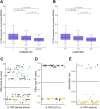IL1RN Variation Influences Both Disease Susceptibility and Response to Recombinant Human Interleukin-1 Receptor Antagonist Therapy in Systemic Juvenile Idiopathic Arthritis
- PMID: 29609200
- PMCID: PMC6105455
- DOI: 10.1002/art.40498
IL1RN Variation Influences Both Disease Susceptibility and Response to Recombinant Human Interleukin-1 Receptor Antagonist Therapy in Systemic Juvenile Idiopathic Arthritis
Abstract
Objective: To determine whether systemic juvenile idiopathic arthritis (JIA) susceptibility loci that were identified by candidate gene studies demonstrate association with systemic JIA in the largest study population assembled to date.
Methods: Single-nucleotide polymorphisms (SNPs) from 11 previously reported systemic JIA risk loci were examined for association in 9 populations, including 770 patients with systemic JIA and 6,947 controls. The effect of systemic JIA-associated SNPs on gene expression was evaluated in silico in paired whole genome and RNA sequencing data from the lymphoblastoid cell lines (LCLs) of 373 European subjects from the 1000 Genomes Project. Responses of systemic JIA-associated SNPs to anakinra treatment were evaluated in 38 US patients for whom treatment response data were available.
Results: We found no association between the previously reported 26 SNPs and systemic JIA. Expanded analysis of the regions containing the 26 SNPs revealed only 1 significant association: the promoter region of IL1RN (P < 1 × 10-4 ). Systemic JIA-associated SNPs correlated with IL1RN expression in LCLs, with an inverse correlation between systemic JIA risk and IL1RN expression. The presence of homozygous IL1RN high expression alleles correlated strongly with a lack of response to anakinra therapy (odds ratio 28.7 [95% confidence interval 3.2-255.8]).
Conclusion: In our study, IL1RN was the only candidate locus associated with systemic JIA. The implicated SNPs are among the strongest known determinants of IL1RN and interleukin-1 receptor antagonist levels, linking low expression with increased systemic JIA risk. Homozygous high expression alleles predicted nonresponsiveness to anakinra therapy, making them ideal candidate biomarkers to guide systemic JIA treatment. This study is an important first step toward the personalized treatment of systemic JIA.
© 2018, American College of Rheumatology.
Figures



Comment in
-
Editorial: Toward Personalized Treatment for Systemic Juvenile Idiopathic Arthritis.Arthritis Rheumatol. 2018 Aug;70(8):1172-1174. doi: 10.1002/art.40501. Epub 2018 Jun 29. Arthritis Rheumatol. 2018. PMID: 29569852 Free PMC article. No abstract available.
References
-
- Woo P. Systemic juvenile idiopathic arthritis: diagnosis, management, and outcome. Nat Clin Pract Rheumatol. 2006;2(1):28–34. - PubMed
-
- Cimaz R. Systemic-onset juvenile idiopathic arthritis. Autoimmun Rev. 2016 - PubMed
-
- Nigrovic PA. Review: is there a window of opportunity for treatment of systemic juvenile idiopathic arthritis? Arthritis Rheumatol. 2014;66(6):1405–13. - PubMed
Publication types
MeSH terms
Substances
Grants and funding
- 20542/ARC_/Arthritis Research UK/United Kingdom
- 20542/VAC_/Versus Arthritis/United Kingdom
- 82517/CIHR/Canada
- R01 AR060893/AR/NIAMS NIH HHS/United States
- DH_/Department of Health/United Kingdom
- Z99 AR999999/ImNIH/Intramural NIH HHS/United States
- R01 AR059049/AR/NIAMS NIH HHS/United States
- R01 DK076025/DK/NIDDK NIH HHS/United States
- P30 AR070549/AR/NIAMS NIH HHS/United States
- G0000934/MRC_/Medical Research Council/United Kingdom
- 076113/C/04/Z/WT_/Wellcome Trust/United Kingdom
- WT_/Wellcome Trust/United Kingdom
- MR/R013926/1/MRC_/Medical Research Council/United Kingdom
- MR/M004600/1/MRC_/Medical Research Council/United Kingdom
- U01 DK062420/DK/NIDDK NIH HHS/United States
- ZIA AR041198/ImNIH/Intramural NIH HHS/United States
- R01 AR061297/AR/NIAMS NIH HHS/United States
- 20385/ARC_/Arthritis Research UK/United Kingdom
- 068545/Z/02/WT_/Wellcome Trust/United Kingdom
LinkOut - more resources
Full Text Sources
Other Literature Sources
Medical

